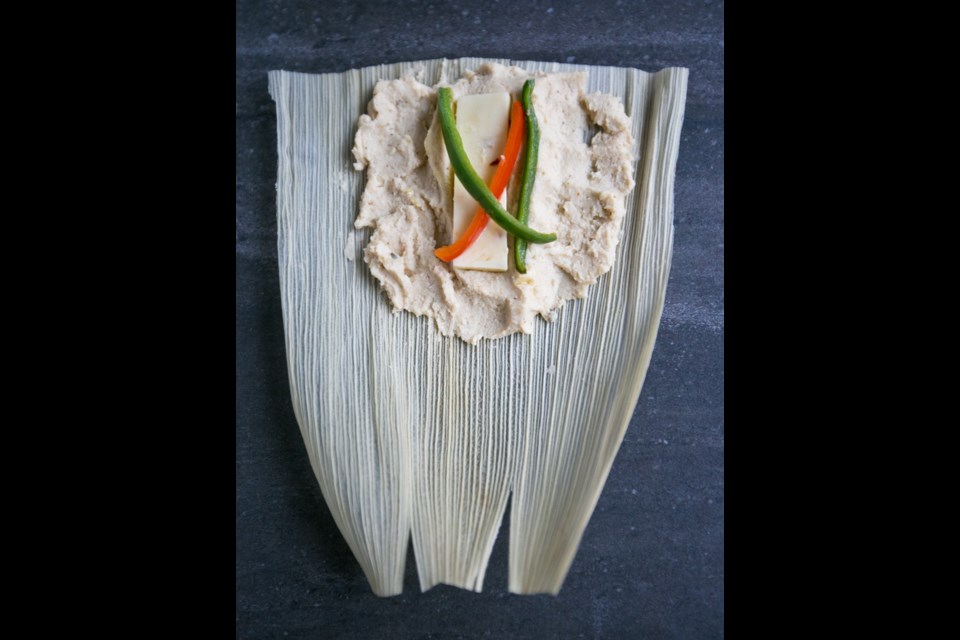 During a recent trip to San Antonio, Texas, I discovered the city’s famed river walk, historic missions and inspiring McNay Art Museum were pleasures to visit.
During a recent trip to San Antonio, Texas, I discovered the city’s famed river walk, historic missions and inspiring McNay Art Museum were pleasures to visit.
As expected, I also found that with such a large Hispanic population, there is an array of places to enjoy great Latin American food and Mexican cuisine in particular. But what I didn’t expect to find out was that many folks in San Antonio are crazy for one particular dish, tamales.
In fact, they’re so in love with them they hold a tamale festival (atpearl.com/tamales) each December. Thousands of people attend this free event to have a good time and eat a mountain of tamales sold by dozens of vendors.
Tamales are made by stuffing and folding corn husks, used for wrapping, not eating, with masa (corn dough) and a filling, such as meat, cheese and/or vegetables, and then steaming them. There are also seafood-filled tamales and sweet dessert ones. Other wrappers, such as banana leaf, are also used.
To find out why there’s such a taste for them in San Antonio, I spoke with Gloria Solis, a tamale-making expert who demonstrates how to make them at that city’s family-oriented Witte Museum (wittemuseum.org).
“The tradition of old-school food makes tamales a delicacy for the Mexican population here,” Solis said.
What Solis means by old-school food are the dishes that immigrants from Mexico brought to the area and never stopped making, enjoying and passing on from one generation to the next.
For example, Solis learned to make tamales from her mother, while her mother and aunts learned from their mother and so on down the line.
According to the Oxford Companion to Food, that tamale-making lineage goes back a long, long time. That book says tamales are an important feature of Mexican food and date back to pre-Columbian times.
Tamales were first cooked in hot ashes, but as the Aztecs learned new cooking techniques from Spanish conquistadores, they eventually began to be steamed, first in pits and then in pots — what’s most often used today.
In Diana Kennedy’s classic book The Essential Cuisines of Mexico, she writes that in Mexican culture, tamales are made for an occasion, and an occasion is made of making them.
Solis agrees and says while they are very popular around Christmas time in San Antonio, any festive time is the right time for tamales.
“In our family if someone is having a quinceañera [a 15-year-old girl’s birthday celebration], or a graduation celebration, we come together,” Solis said.
“If [tamales are] the entrée that the special person wants, it’s served.”
Tamales are wonderful to eat, but in Mexican culture, making them is just as enjoyable and very much an occasion, as Kennedy noted.
When there is a gathering where tamales will be served, a tamalada (tamale-making party) is held. It’s a multifamily, multigenerational event where young and old gather to share in the work of making tamales, tell stories and have fun. It’s also a very efficient way to make the dozens of tamales needed for the occasion, something that would take a lot of time if you did it yourself.
With that in mind, today I’ve included a smaller batch version of tamales with a simple filling. It yields 16 tamales and will give you a taste of what’s involved in making them. Lard is traditionally added to the masa for richness and to help it more easily pull away from the corn husk when cooked. In my recipe I’ve also given you the option to use vegetable shortening.
If you enjoy making the tamales, expand the recipe next time, invite some family and friends over and have a tamalada.
You could also experiment with other tamales fillings, such as the pork and chicken ones that Solis says are popular in San Antonio.
Cheese and Three-Pepper Tamales
This recipe yields 16 tamales. In it, I ask you to soak 20 corn husks to make them. I did that just in case one breaks and also to provide some corn husk you can cut into strips and tie the tamales with. Make a filling meal by serving the tamales with such things as salsa, hot pepper sauce, sour cream, rice, beans and chopped cilantro or green onion.
Preparation time: 45 minutes, plus corn husk soaking time
Cooking time: one hour
Makes: four (four tamales each) servings
For the corn husks
20 dried corn husks (see Note 1)
Place the corn husks in a large, deep bowl and cover with warm water. Let husks soak until softened and pliable, at least one hour. Drain the corn husks and use as directed below.
For the masa (corn dough)
2 cups corn masa mix (see Note 2)
2 to 2 1/4 cups chicken or vegetable broth or stock
1/3 cup vegetable shortening or room temperature lard
1 tsp salt
1/8 tsp baking powder
1/2 tsp ground cumin, or to taste
1/2 tsp oregano, or to taste
1/2 tsp chili powder, or to taste
Thoroughly combine all ingredients in a bowl to create a soft dough. Use as directed below.
For filling and to finish
2 tsp olive oil
16 strips jalapeño pepper, each about 3 inches long and 1/4 inch wide
16 strips red bell pepper, each about 3 inches long and 1/4 inch wide
16 strips poblano pepper, each about 3 inches long and 1/4 inch wide (see Note 3)
16 small pieces regular or Jalapeño-flavoured Monterey Jack cheese, each about 3 inches long and 1/4 inch wide
Heat the oil in a skillet set over medium-high. Add the jalapeño pepper and cook and stir one minute. Lift the jalapeño pepper out of the pan and set on a small plate. Add the bell and poblano peppers to the skillet and cook two minutes. Set them on a second small plate.
To make a tamale, set a corn husk, curved-side-down, on a work surface, with the pointed end facing you. Place scant 1/4 cup of the masa (corn dough) in the centre of the wide end of the corn husk. Spread or press out the masa into a rectangle that’s about four inches tall and wide. Set a piece of the cheese in the centre of the masa. Top the cheese with a strip each of jalapeño, bell and poblano pepper.
Fold the sides of corn husks over the filling. Turn the tamale over so that it’s folded side down. Fold the pointed, unfilled end of the tamale over the filled portion. Ensure the tamale stays folded by tying it with a long, 1/4-inch wide strip of corn husk. Fill and fold 15 more tamales in this fashion.
To cook, stand the tamales upright on there folded ends, tightly packed together, in a tall steamer. Cover and steam over simmering water about 60 minutes, or until the masa is set and easily pulls away from the corn husk when opened.
To serve, divide the tamales among plates and let diners unwrap and top and serve them with items noted in the recipe introduction.
Note 1: Corn husks are not easy to find in Victoria. Places to try are The Market on Yates (250-381-6000), The Market On Millstream (250- 391-1110), and Mexican House Of Spice (250-388-6602). Call first to determine availability. If you can’t find them, you could use eight-inch squares of banana leaf to fill, fold and make the tamales with. Banana leaves are sold in Chinatown and at the Mexican House of Spice.
Note 2: Corn masa mix is a ground corn mixture. You’ll find it at the stores noted above. The brand I used was Minsa Nixtamalized Corn Masa Mix. Nixtamalized refers to a process for the preparation of corn in an alkaline solution, usually limewater.
Note 3: Fresh poblano peppers are sold at many supermarkets. If you can’t find it, use another type, such as yellow bell pepper.
